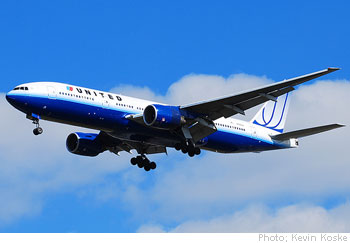 Airlines are a classic case of free market versus regulation, competition versus monopoly, and consumers versus business. Thursday’s Senate Judiciary hearing on the pending United (UAUA) – Continental Airlines (CAL) merger laid out the issues. Airline executives touted lower costs, better travel options under “an unparalleled global network,” and more stable employment for its workers. The Consumers Union charged consumers would face less choice and fewer flights, loss of service to smaller cities, higher fares, reduced quality of service, and the creation of another “too big to fail” corporation. My recent travel experiences — fewer available and more costly seats plus annoying extra charges for my first bag, for poor food, and for an Internet connection — support charges of growing monopoly power for the four major U.S. carriers that would remain if this merger goes through. We’re awaiting a Justice Department decision.
Airlines are a classic case of free market versus regulation, competition versus monopoly, and consumers versus business. Thursday’s Senate Judiciary hearing on the pending United (UAUA) – Continental Airlines (CAL) merger laid out the issues. Airline executives touted lower costs, better travel options under “an unparalleled global network,” and more stable employment for its workers. The Consumers Union charged consumers would face less choice and fewer flights, loss of service to smaller cities, higher fares, reduced quality of service, and the creation of another “too big to fail” corporation. My recent travel experiences — fewer available and more costly seats plus annoying extra charges for my first bag, for poor food, and for an Internet connection — support charges of growing monopoly power for the four major U.S. carriers that would remain if this merger goes through. We’re awaiting a Justice Department decision.
The airline execs said they face plenty of competition from low cost carriers, particularly Southwest, but GAO’s “analysis of 2009 ticket data showed that combining these airlines would result in a loss of one effective competitor (defined as having at least 5 percent of total traffic between airports) in 1,135 markets (called airport pairs) affecting almost 35 million passengers while creating a new effective competitor in 173 airport pairs affecting almost 9.5 million passengers (fig.). However, in all but 10 of these airports pairs there is at least one other competitor.” GAO also noted that, “Although the airline industry has experienced numerous mergers and bankruptcies since deregulation [in 1978], growth of existing airlines and the entry of new airlines have contributed to a steady increase in capacity, as measured by available seat miles.” Since deregulation in 1978, airline fares have declined 36% after adjusting for inflation. So deregulation worked, sort of.
Warren Buffett famously quipped in 2002 that “if a capitalist had been present at Kitty Hawk back in the early 1900s, he should have shot Orville Wright. He would have saved his progeny money. But seriously, the airline business has been extraordinary. It has eaten up capital over the past century like almost no other business because people seem to keep coming back to it and putting fresh money in. You’ve got huge fixed costs, you’ve got strong labour unions and you’ve got commodity pricing. That is not a great recipe for success. I have an 800 (free call) number now that I call if I get the urge to buy an airline stock. I call at two in the morning and I say: “My name is Warren and I’m an aeroholic.” And then they talk me down.”
Speaking of Kitty Hawk, with no outside support, Orville and Wilbur Wright beat numerous foreign government funded competitors to fly the first practical airplane on December 17, 1903. They tried to sell their airplane to the governments of the United States, Britain, France, and Germany, but they were turned down because they insisted on a signed contract before any demonstration flights. Like inventors to this day, they feared their ideas would be stolen. The U.S. Army had just spent the enormous sum of $50,000 for Samuel Langley’s Aerodrome, only to watch it plunge into the Potomac River on October 7, 1903. The Wright Brothers’ initial U.S. patent application of 1903 was rejected, but an attorney secured their patent on May 22, 1906. Then, in August and September of 1908, demonstration flights by Wilbur in France and by Orville at Fort Myer, Virginia captured world attention. After Orville’s crash on September 17, 1908, which killed the first ever military passenger, the Wright brothers sold their first airplane to the Army for $30,000. Almost immediately, a patent war erupted with Glenn Curtis, who had invented ailerons in place of wing warping. The Wright’s won that legal battle in 1914. During World War I, the U.S. government stepped in, forced cross-licensing agreements, and paid $2 million each to the Wright Brothers and to Curtis to clear the way for war production. After the war, the first fledgling airlines survived on airmail contracts from the U.S. Postal Service. Herbert Hoover’s Postmaster General W. F. Brown changed those contracts to encourage the use of passenger aircraft, and the rest is history.
- Bulenox: Get 45% to 91% OFF ... Use Discount Code: UNO
- Risk Our Money Not Yours | Get 50% to 90% OFF ... Use Discount Code: MMBVBKSM
Disclaimer: This page contains affiliate links. If you choose to make a purchase after clicking a link, we may receive a commission at no additional cost to you. Thank you for your support!


Leave a Reply